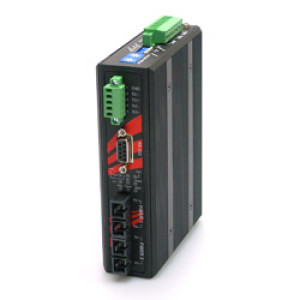Your shopping cart is empty!
MENU

RS-232 transmission distance is limited by cable capacitance. Distances greater than 50' (15.2m) will reduce signal strength, leading to corrupt data and possibly complete signal loss. This makes it unsuitable for reliable long-distance communication. The low-cost solution is to convert RS-232 signals to an alternative format. RS-422 and RS-485 can handle 4,000' (1,200m). Fiber optic signals can be sent over much greater distances.
The declining availability of RS-232 ports on computing equipment is another reason for signal conversion. Converting RS-232 serial signals to USB lets a single PC receive connections from one or more serial devices. In certain situations, electrical noise can disrupt serial signals and potentially damage sensitive equipment. The solution is an RS-232 repeater providing surge protection.
Serial communication is built into equipment found in many different sectors.
It's used in building access, automation equipment, and process control. In industrial sites, it's used for data acquisition, process control, and automation.
Users often send data to a central location, typically for logging on a PC or for decision-making purposes. Many older pieces of equipment were built with only RS-232 outputs, so transmission requires conversion and possibly reconversion at the receiving end. It's not uncommon to have an RS-232 source converted into RS-422 or fiber optic signals for long-distance transmission. Then, at the receiving end, it's converted back into RS-232 and finally to USB, allowing multiple devices to communicate with a single PC.
Westward has converters for serial (RS-232/422/485) to fiber, serial (RS-232) to serial (RS-422/485), and serial (RS-232 or RS-422/485) to USB. These devices are manufactured by top-tier companies like Black Box, TRENDNet, and Antaira Technologies, which warranty their products for 5 years or better.
Resistant to EMI, fiber can send signals many miles. The Antaira STF-300C-CM02 is an economical solution for converting RS-232/422/485 signals for fiber transmission. For a more robust solution, consider the STF-401C compact industrial serial-to-fiber media converter. DIN-rail mountable, it's a good solution for process control and industrial automation. To extend a serial line, consider the TD-1280 or TD-1590, which utilize single or multimode fiber to reach distances of up to 20 km.
Converting the output from RS-232 to RS-422 or RS-485 significantly increases the maximum transmission distance. The STS-1915S performs this conversion and can work as either a client or server, providing RS-422/485 serial communication through the standard RS-232 port.
These devices let a PC or laptop with no serial port send and receive data. At their simplest, they comprise a cable with a male USB connector at one end and a block incorporating a DB9 connector and conversion electronics at the other. The UTS-1110A handles RS-232 to USB conversion while the UTS-1458B does the same for RS-422/485. When isolation is needed, the UTS-1461A-SI and UTS-401BK-SI perform the same one-to-one conversion but with addedl protection.
Similar converters are available for when it's useful to put multiple RS-232 cables into a single USB port. The UTS-404A has two male DB9 connectors, thehas four, UTS-408A has eight and the UTS-416AK accepts 16 RS-232 inputs.
Westward Sales supplies rugged serial converters designed to bridge legacy and modern equipment. Our selection includes RS-232 to RS-485/422 converters, USB-to-serial adapters, and serial-to-Ethernet interfaces for automation, networking, and control systems. Units are available with surge protection, wide temperature tolerance, and DIN-rail mounting for industrial environments.
Whether you need an industrial serial or USB conversion, Westward Sales is ready to configure a communication solution that works. Contact us today. We promise a quick and informed response from our team.